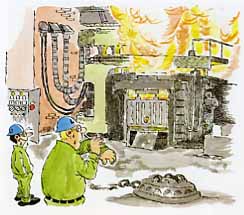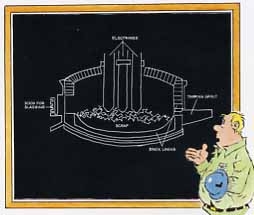


Until fairly recently, electric furnaces were used mostly to make specialty steels, such as stainless steel, and to refine small batches of carbon and alloy steel. However, the development of large furnaces now makes the electric furnace process a practical way to produce high tonnages of carbon steel.
J&L currently operates five small electric furnaces (70-80 ton capacity) at our Warren Plant, and two medium-size furnaces (195-ton capacity) in Cleveland. In 1979, we will complete installation of two large units (350-ton capacity) at our Pittsburgh Works. These electrics will replace six open hearth furnaces at the Pittsburgh Works. Basically the quality of steel from an open hearth is excellent but the process, which takes from 8 to 10 hours, is too slow to remain competitive in today's steel market.
An electric furnace, or more properly, an electric arc furnace, is a round bottom pot lined with heat-resistant brick. It has a removable lid, or roof, that swings aside when the furnace is charged.
The modern electric arc furnace is an extremely versatile steelmaking furnace. Almost any type of carbon steel can be made in it at a rate of 100 tons per hour.
Virtually all electric furnaces are charged with cold metal. This can be carefully selected steel scrap, the most common charge, or chunks of solidified blast furnace iron called pig iron.
An electric furnace has three large electrodes that protrude through its roof (above). These electrodes are lowered close to the surface of the charge, then energized to produce powerful lightening-like electric arcs that pass between the electrodes and the metal. The enormous energy in the arcs melts the charge rapidly and keeps it molten.
Limestone is usually added to the melt to create a slag that captures the impurities in the charge. And, some iron ore may be thrown in to provide an internal source of oxygen to remove excess carbon.
It's common electric furnace practice to insert a hand-held oxygen lance through the furnace's side-mounted door. The oxygen helps burn away excess carbon.
The refining process then reduces the carbon
level to the proper value for the kind of steel being made.